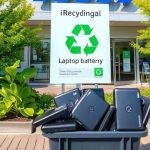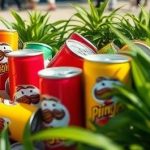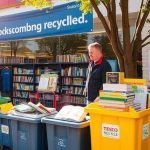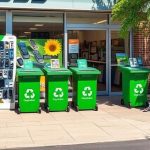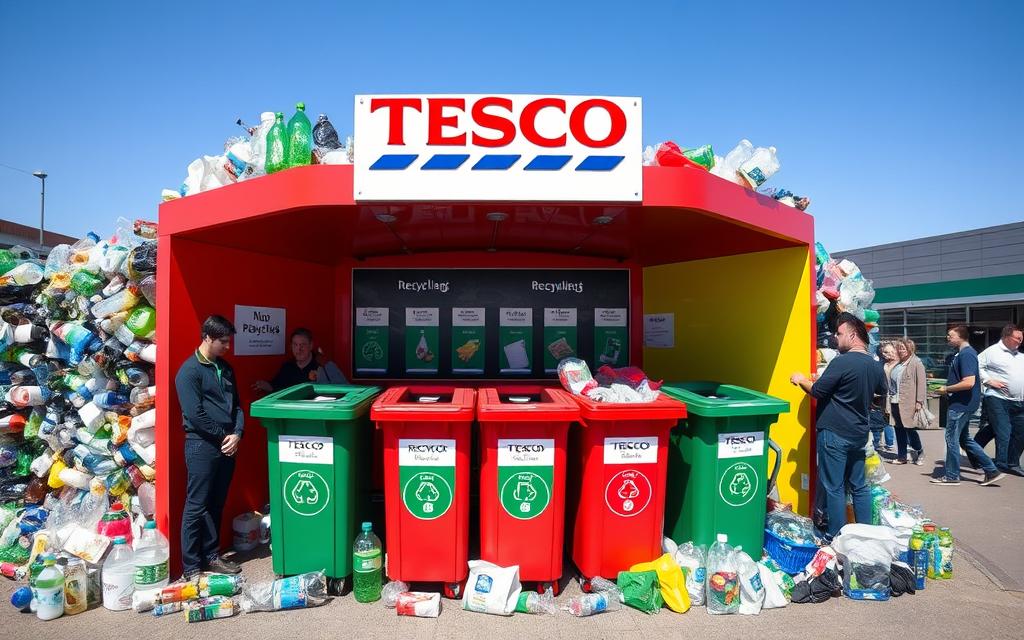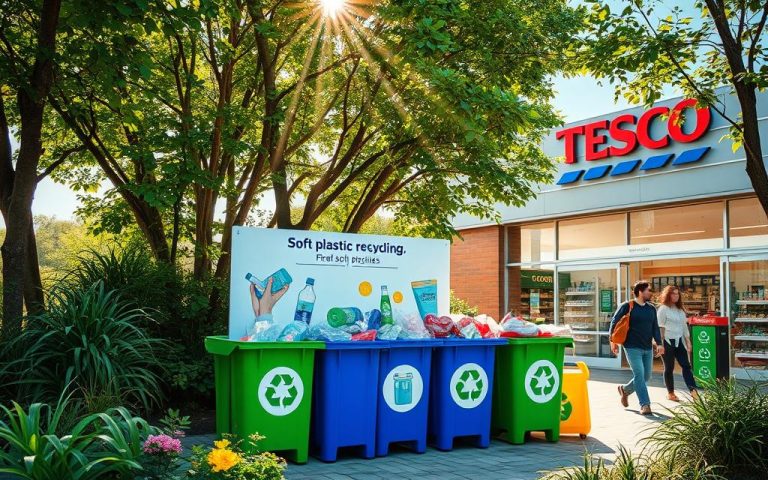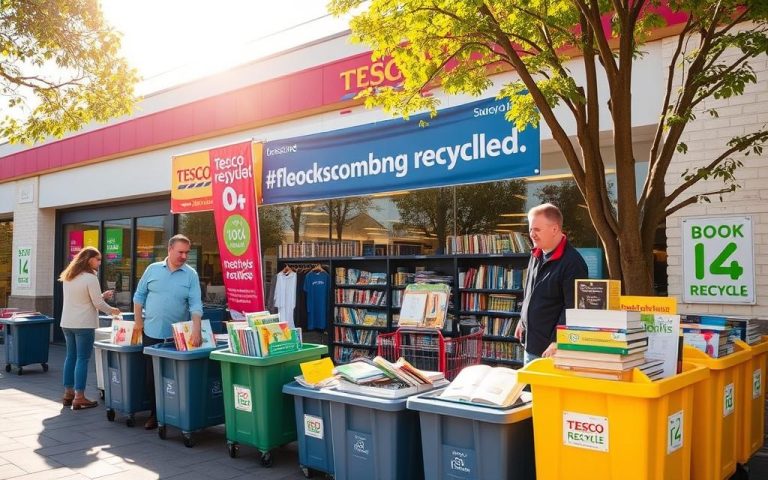The Plastics Tesco Accepts for Recycling Explained
Tesco is transforming plastic recycling across the UK. Their innovative programme has removed nearly 1.5 billion plastic pieces from operations. This shows a strong commitment to protecting our environment.
Tesco’s recycling focuses on specific plastic types. They accept Type 1 (PET), Type 2 (HDPE), and Type 3 (PVC) plastics. Customers receive clear guidance on what materials they can recycle.
You can bring various items to participating Tesco stores. These include plastic drinks bottles, fabric conditioner bottles, and bleach containers. Shampoo packaging and squash bottles are also accepted.
This initiative helps reduce waste significantly. It supports the goal of creating a more eco-friendly shopping experience. However, Types 4-7 plastics are not currently accepted.
Knowing which plastics can be recycled is crucial. It helps support Tesco’s environmental efforts. This knowledge also reduces overall plastic waste in our communities.
Understanding Tesco’s Sustainable Recycling Programme
Tesco leads the way in environmental responsibility with its comprehensive recycling programme. The company has transformed grocery retail by reducing waste and minimising ecological impact across the UK.
Tesco’s Environmental Impact and Goals
Tesco has made remarkable progress in its sustainability efforts. The supermarket has cut over 3,000 tonnes of packaging since 2019.
They’ve also eliminated 1.7 billion pieces of plastic from UK operations. Additionally, Tesco has introduced innovative recycling solutions across its stores.
- Cut over 3,000 tonnes of packaging since 2019
- Eliminated 1.7 billion pieces of plastic from UK operations
- Introduced innovative recycling solutions across stores
The Journey to Zero Waste
Tesco’s zero waste strategy focuses on practical, consumer-driven solutions. The Loop trial showcased the potential for reusable packaging with impressive results.
| Metric | Achievement |
|---|---|
| Branded Lines in Trial | 53 products |
| Own-Brand Products | 35 products |
| Total Products Purchased | Over 80,000 |
Programme Implementation Across UK Stores
The recycling programme includes various initiatives, with a focus on soft plastic collection. Tesco has established collection points in 171 stores, mainly in South West England and Wales.
These points target hard-to-recycle materials like crisp packets, salad bags, and bread bags. This approach makes recycling more accessible for customers.
“Our goal is to make recycling accessible and convenient for every customer,” says a Tesco sustainability spokesperson.
Consumer motivations show growing environmental awareness. Half of customers want to “do their bit for the planet”.
- 50% want to “do their bit for the planet”
- 39% motivated by reuse potential
- 25% driven by product quality
Tesco’s recycling programme balances environmental responsibility with practical solutions. It shows a strategic approach to sustainability that meets consumer needs.
What Plastics Can Be Recycled at Tesco
Tesco leads in recyclable plastics management with innovative recycling points across nearly 200 UK stores. They offer customers many ways to dispose of various plastic types responsibly.
Tesco’s recycling programme accepts a wide range of plastic types. This makes it easier for eco-conscious shoppers to reduce waste. Here are the plastic materials you can recycle at Tesco:
- Bread bags
- Fruit and vegetable packaging
- Crisp packets
- Salad bags
- Flexible food packaging
- Plastic film and wrapping
Not all plastics are created equal. Tesco has strict guidelines to ensure effective recycling of plastic types. Customers must return clean plastics without food residue.
| Plastic Type | Recyclability at Tesco |
|---|---|
| Soft Plastics | Fully Accepted |
| Own-Brand Packaging | Guaranteed Recycling |
| Plastic Film | Accepted at Recycling Points |
“Our goal is to make recycling as simple and accessible as possible for our customers,” says a Tesco sustainability spokesperson.
About 900 Tesco stores now offer recycling points. They aim to collect 1,000 tonnes of soft plastics yearly. Tesco has already removed one billion plastic pieces from its operations.
This effort reduces packaging by 3,500 tonnes each year. It shows Tesco’s commitment to sustainable waste management.
Tesco’s Soft Plastics Collection Initiative
Tesco has launched a nationwide programme to tackle plastic waste management. This initiative offers customers easy recycling solutions, showing Tesco’s dedication to environmental sustainability.
The programme creates accessible ways for people to recycle soft plastics. It’s a significant step towards reducing plastic waste and promoting a circular economy.
Collection Points and Locations
Tesco has added collection points in 171 new stores. This expansion follows a successful trial that began in 2018.
Now, over 900 Tesco stores have soft plastics collection points. Customers can easily recycle items like crisp packets and bread bags in-store.
- Over 900 Tesco stores now feature soft plastics collection points
- Customers can recycle items like crisp packets, bread bags, and fruit packaging
- Convenient in-store recycling locations make plastic recovery easier
Processing and Recovery Rates
Tesco aims to collect and recycle 1,000 tonnes of plastic annually. They’ve achieved an impressive 80% recovery rate for returned soft plastics.
“We’re transforming plastic waste into a valuable resource,” says a Tesco sustainability spokesperson.
Environmental Benefits
This programme tackles a big environmental issue. Up to 50% of supermarket packaging is non-recyclable, making Tesco’s initiative crucial.
- Reducing plastic waste in landfills
- Promoting a circular economy for plastics
- Encouraging consumer participation in recycling
Tesco sends about 25 tonnes of collected soft plastics monthly to recycling facilities. They work with places like Berry’s in Heanor to process the plastics.
Preparing Materials for Recycling
Proper recycling preparation is vital for Tesco’s programme success. Clean recyclables ensure materials can be reused effectively. This reduces waste and helps the environment.
- Remove all food residue completely
- Separate different packaging components
- Check local recycling capabilities
- Remove non-recyclable attachments
“Clean recycling is good recycling” – Tesco Sustainability Team
Tesco suggests specific methods to boost recycling quality:
- Rinse containers with cold water
- Dry items completely to prevent mould
- Squash packaging to save space
- Remove labels when possible
Soft plastics make up 26% of UK plastic packaging. Tesco now accepts seven types of soft plastic packaging. These include cling film, bread bags, and crisp packets.
Nearly 200 Tesco stores now collect these soft plastics. This makes proper recycling preparation even more crucial.
Pro tip: Always check local recycling guidelines to ensure maximum effectiveness in your recycling efforts.
How Tesco’s Recycling Programme Compares to Other Supermarkets
Tesco leads the pack in supermarket recycling innovations. Their comprehensive approach tackles environmental challenges head-on. This sets them apart from competitors in the retail sector.
Industry Standards and Innovations
Tesco’s plastic recycling efforts are truly remarkable. They’ve launched soft plastic recycling points in nearly 200 stores. During initial trials, they recovered over 80% of returned soft plastics.
Their goal is impressive: collect more than 1,000 tonnes of soft plastics yearly. This initiative addresses critical environmental concerns in a practical way.
Success Metrics and Performance
| Recycling Metric | Tesco Achievement | Industry Benchmark |
|---|---|---|
| Plastic Packaging Reduction | 1.8 billion pieces removed | 5.25% national soft plastic recycling rate |
| Packaging Recyclability | 90% currently recyclable | Less than 50% industry average |
| Recycled Content in Packaging | 30% rPET in own-brand products | Minimal industry adoption |
Future Development Plans
Tesco’s sustainability commitment goes beyond current achievements. They’ve set ambitious targets to transform their environmental strategy:
- 100% recyclable packaging by 2025
- Remove 500 million plastic pieces
- Expand soft plastic recycling nationwide
In an industry where only 18% of shoppers are aware of recycling schemes, Tesco is leading the charge towards a more sustainable future.
Tesco’s innovative recycling strategies showcase their environmental leadership. They also encourage customers to adopt sustainable practices. This approach benefits both the company and the planet.
Conclusion
Tesco’s recycling programme marks a key step in retail’s commitment to sustainability. It tackles the UK’s annual 400,000-tonne soft plastic waste challenge. The initiative transforms soft plastic waste into valuable resources.
Customer involvement is crucial to this recycling effort. Tesco’s collection points allow people to contribute to environmental conservation. This programme is vital, as only 16% of UK local authorities collect soft plastic.
Tesco’s ambitious targets showcase the programme’s success. They aim to collect over 1,000 tonnes of plastic yearly. More than 80% of returned soft plastics can be recovered.
The retailer plans to use at least 30% recycled materials in packaging. They also aim to keep 90% of packaging ‘widely recycled’. These goals set new standards for sustainable retail practices.
Tesco’s initiative serves as a powerful model for other businesses. It shows that environmental responsibility can align with commercial success. This approach inspires both consumers and companies to view waste as a resource.
FAQ
What types of plastics can I recycle at Tesco?
Tesco accepts various recyclable plastics, including soft plastics like crisp packets and bread bags. They collect own-brand packaging and hard-to-recycle materials to support sustainability efforts.
How do I prepare my recyclables before bringing them to Tesco?
Clean all packaging thoroughly and remove food residue. Separate different packaging parts and check local recycling rules.
Ensure your materials meet Tesco’s recycling standards before bringing them in.
Where can I find Tesco’s plastic recycling collection points?
Recycling collection points are in Tesco stores across the UK. These areas allow customers to drop off soft plastics and packaging.
What happens to the plastics I recycle at Tesco?
Tesco recovers 80% of returned soft plastics. The collected materials are processed and transformed, helping to reduce landfill waste.
This process promotes sustainable resource management and contributes to a circular economy.
What are Tesco’s goals for plastic recycling?
Tesco aims for zero waste with ambitious targets. They plan to collect over 1,000 tonnes of plastic yearly.
They’re always improving their recycling programme to reduce environmental impact.
How does Tesco’s recycling programme compare to other supermarkets?
Tesco leads in sustainability with innovative recycling solutions. They often exceed industry standards and continually improve their programme.
This keeps them at the forefront of environmental responsibility in retail.
Can I recycle packaging from non-Tesco branded products?
Tesco mainly recycles their own-brand packaging. However, they suggest checking collection points for acceptance of other branded materials.
How can I learn more about Tesco’s recycling efforts?
Visit Tesco’s website for detailed information about their recycling programme. Store colleagues can also help with queries about collection points and sustainability initiatives.



